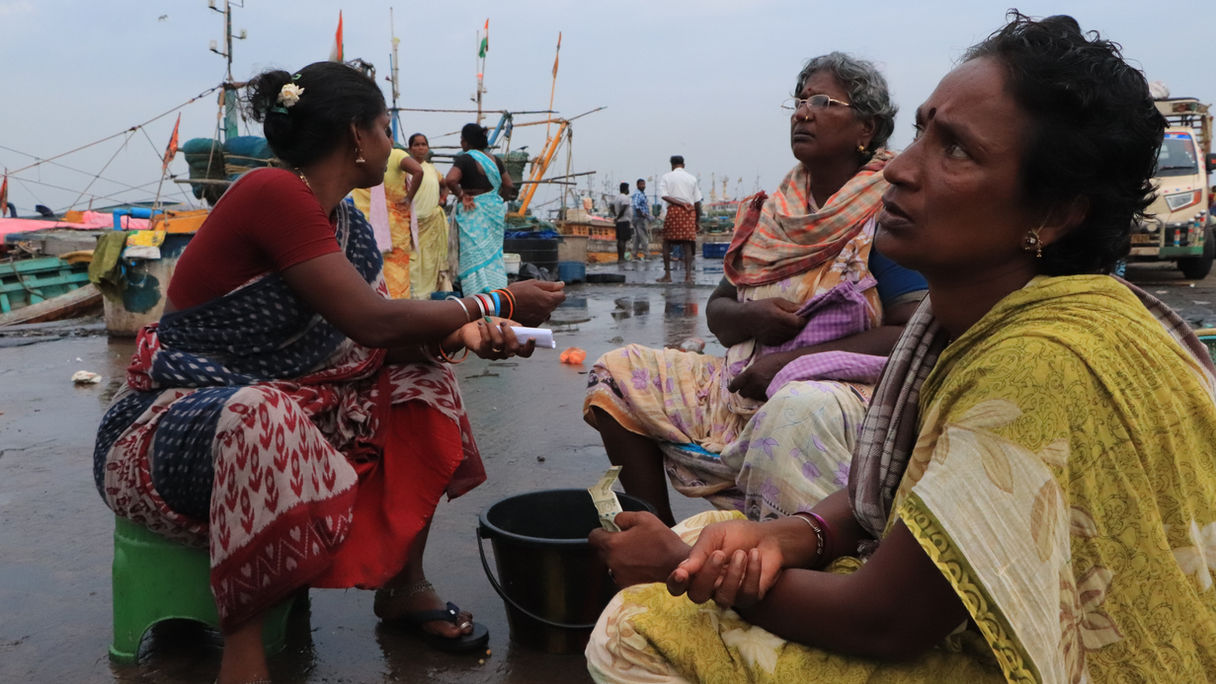Women in fishing industry
Kakinada: It is the last day of 2023’s fishing season before the annual fishing ban begins on the East coast of India on 15 April. Trawlers filled with the season’s last catch make their way to the newly developing Ameenabad harbor in Uppada, Andhra Pradesh.
It means that it is also the last chance to sell fresh fish brought by the trawlers for many fisher widows. It is a highly competitive market. The day starts as early as 03:00am.
At the Ameenabad harbor, which is still under construction, many women rely on these trawlers for their livelihood. Nothing goes to waste here.
Once docked, the men segregate the fish on the boat and sell it to the women. The women in turn sell this in local markets during the day. Some of the catch includes Oil sardines (Kavallu), Sharks (Sorachepa), Ornate Emperor (Erimeenu), Mackerel (Kanaganthalu), Prawns (Royyalu).
The remaining waste from the nets such as clams, crabs, sea shells, and damaged fish is collected by another group of women who sell it to various animal feed industries. This by-product is used to make fertilizer, fish meal, and poultry feed and has different grades to it.
Drying of fish for consumption is also undertaken by the fisherwomen. It is a separate market in itself.
At the local markets, it is mostly older women who are allowed to re-sell the fish. It is restricted for younger women, especially young widows, to be seen out in public spaces unaccompanied by a male member.
The younger women usually stick to cleaning and peeling the fish and shrimp as it can be done from behind the counters, away from sight.
As per this report, women constitute around 50% of the total fishing community’s population and comprise one-third of the labor force in India. The women are actively bridging supply chain gaps within the industry.
However, when a fisher woman's husband goes missing at sea, she has to wait for seven years before the Indian law pronounced him dead. Only then is she legally entitled to avail the benefits of various government schemes for widows.
In the meanwhile, the community already declares and treats her as a widow. In the case of a fisher widow, she is often left landless with children to take care of. Segregation, poverty, social outcasting are common perils of this system. She cannot earn a livelihood by reselling fish in the market owing to the community's beliefs. The young widow solely relies on daily wage work in such an instance.
In India, out of a population of 5.4 million active fishers, 3.8 million are fishermen and 1.6 million are fisherwomen. Despite the important role women play in this industry, only in 2019 did the Indian government recognize the importance of setting up a dedicated department towards fisheries and the community’s welfare.
When we think of fishing, we imagine men operating boats, engaging in fishing, and handling the fish's sale and trade. Although the post-harvest tasks of fishing, such as carrying catch from the fish-landing locations to the local markets, cleaning, drying, marketing, selling, and trading of fish, are largely carried out by women.
Women in Indian fisheries are underrepresented and are rarely allowed to participate in meetings, workshops, or decision-making processes. Loans and subsidies are also designed that are only easily accessible and available to men. These increase the barriers for women's participation in the fishing sector already-expanding social, cultural, gender, and religious bias.
Despite systemic barriers, the women in the Indian fishing industry have made a niche for themselves in a male dominated industry. The country needs to take into account the challenges this section of the women face to make better inclusive policies.
The above story is part of a policy paper, Understanding the Socioeconomic Conditions of Fisherwomen in the Fish Supply Chain of Northern Andhra Pradesh, I wrote for a think tank called SPRF.







